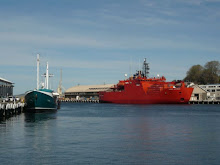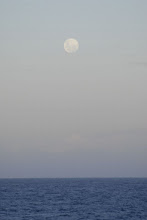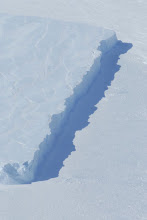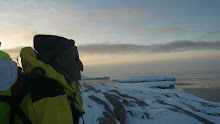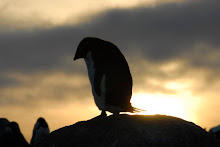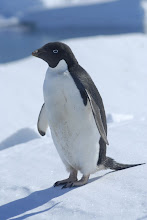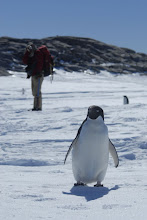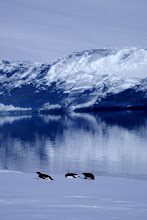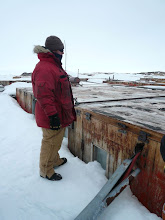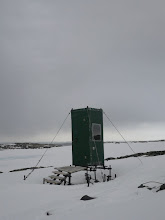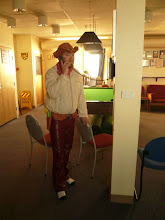 Hello again. Mid-winter’s day is a huge milestone in Antarctic life, as I have said before, and if there is a particular day worth celebrating here you feel this is it. For all that mid-winter means to me back home, I’m sure I will always think of Antarctica at this time of year from now on – of the people who are here, and the people who have wintered here before. After some rough calculations we figured the total number of people on the continent during the 2008 winter would be less than 1000, and that the total number of people who have ever wintered here would be less than the number of people an average AFL match draws to a stadium. Amazing when you think that Antarctica is actually twice the size of Australia (not including the area covered by sea-ice during the winter months)! So on days like mid-winter’s day you feel pretty lucky to be here, and that it’s something worth celebrating. But celebrations are only what you make them, and it was up to us to make the day enjoyable, so here is how we did it:
Hello again. Mid-winter’s day is a huge milestone in Antarctic life, as I have said before, and if there is a particular day worth celebrating here you feel this is it. For all that mid-winter means to me back home, I’m sure I will always think of Antarctica at this time of year from now on – of the people who are here, and the people who have wintered here before. After some rough calculations we figured the total number of people on the continent during the 2008 winter would be less than 1000, and that the total number of people who have ever wintered here would be less than the number of people an average AFL match draws to a stadium. Amazing when you think that Antarctica is actually twice the size of Australia (not including the area covered by sea-ice during the winter months)! So on days like mid-winter’s day you feel pretty lucky to be here, and that it’s something worth celebrating. But celebrations are only what you make them, and it was up to us to make the day enjoyable, so here is how we did it: We started the day with an extravagant morning tea, which included plenty of pastries, fruit salad, muffins, and a large selection of “smoko” bowel-clogging stuff. It may not sound like much, but considering morning tea usually consists of a biscuit and a cup of tea, this was a big hit with the “tradies” on station. Unfortunately I have no photos of this, but you can probably get an idea just by looking at the photos of our mid-winter’s dinner, below.
We started the day with an extravagant morning tea, which included plenty of pastries, fruit salad, muffins, and a large selection of “smoko” bowel-clogging stuff. It may not sound like much, but considering morning tea usually consists of a biscuit and a cup of tea, this was a big hit with the “tradies” on station. Unfortunately I have no photos of this, but you can probably get an idea just by looking at the photos of our mid-winter’s dinner, below.Our next ‘event’ was the mid-winter’s swim, a big tradition in cold climates such as Scandinavia, Iceland, Canada… and Antarctica. Some of the guys cut a 3x3 metre hole in the sea-ice close to the wharf, and then attached a wooden ladder to help people to get in and out. They had done this the day before our swim, but due to the cold temperatures the hole had frozen back over during the night, so it was re-dug before our swim, and reforming ice needed to be continually scooped off the surface as people were going in.
 It was all quite a drawn out process. Only one person was to go in at a time, and they were to be attached to a rope via a harness for safety reasons (down here we are frequently restricted by OH&S red tape). As I am part of the medical team I was to be present during the whole process, but all the time standing around waiting meant I lost a lot of feeling in my fingers and toes (something you get used to here).
It was all quite a drawn out process. Only one person was to go in at a time, and they were to be attached to a rope via a harness for safety reasons (down here we are frequently restricted by OH&S red tape). As I am part of the medical team I was to be present during the whole process, but all the time standing around waiting meant I lost a lot of feeling in my fingers and toes (something you get used to here).  It was interesting to watch people’s reactions to the cold water. Once in, it took most people a good few seconds before they could stop making shivering sounds and start talking, and even then words were few and far between. I promised myself that when I went in I wouldn’t make any shivering sounds, but I found that in truth I really didn’t have much control over what sounds I made.
It was interesting to watch people’s reactions to the cold water. Once in, it took most people a good few seconds before they could stop making shivering sounds and start talking, and even then words were few and far between. I promised myself that when I went in I wouldn’t make any shivering sounds, but I found that in truth I really didn’t have much control over what sounds I made. 
 I also noticed that nobody really smiled while they were in the water, but conversely, once they were out, they couldn’t stop themselves from smiling. Before the swim I had only planned on going in up to my waist, but once in that far I felt the water wasn’t as cold as I had expected, and so I went under.
I also noticed that nobody really smiled while they were in the water, but conversely, once they were out, they couldn’t stop themselves from smiling. Before the swim I had only planned on going in up to my waist, but once in that far I felt the water wasn’t as cold as I had expected, and so I went under. 
 Despite my hair freezing in the –22 degree air temperature within minutes of my getting out, my fingers and toes were really the only parts of me that needed warming, and for that we had a heated shipping container nearby.
Despite my hair freezing in the –22 degree air temperature within minutes of my getting out, my fingers and toes were really the only parts of me that needed warming, and for that we had a heated shipping container nearby. After the swim, a number of us chose to relax and warm up in the spa, which had been specifically placed just in front of the Red Shed for the day (another Casey tradition on mid-winter’s day). With a water temp of around thirty-eight degrees, and an air temp of around minus twenty, we had a temperature difference of fifty degrees between head and body!
After the swim, a number of us chose to relax and warm up in the spa, which had been specifically placed just in front of the Red Shed for the day (another Casey tradition on mid-winter’s day). With a water temp of around thirty-eight degrees, and an air temp of around minus twenty, we had a temperature difference of fifty degrees between head and body!
 As you can see from Tod’s photos, steam from the water settling in our hair made for an amusement afternoon spa, during which we all ages about fifty years.
As you can see from Tod’s photos, steam from the water settling in our hair made for an amusement afternoon spa, during which we all ages about fifty years. 
 The mid-winter dinner is a huge part of the day’s festivities, and something the chef works very long and hard to make special.
The mid-winter dinner is a huge part of the day’s festivities, and something the chef works very long and hard to make special. As you can see, for 19 people the quantity of food was totally ridiculous, but given the only fresh produce came from our meagre hydroponics facilities, the quality was first rate, and something everyone appreciated.
As you can see, for 19 people the quantity of food was totally ridiculous, but given the only fresh produce came from our meagre hydroponics facilities, the quality was first rate, and something everyone appreciated.

 This is a time when several speeches are made. Anyone can make a speech, or toast, but after putting together both a formal and an informal invitation for people to send out (to friends, family, loved ones, celebrities, members of parliament etc etc), I was asked to read out some of the more interesting responses received, and toast to those people who would like to be here, but couldn’t be. I included in this a response I received myself from a friend (who shall remain nameless), in which I was worried he had actually bought himself a ticket to Hobart and was waiting there for instructions on how to catch the next flight to Casey. It was a good reminder of how little people know about this place, and how lucky I am to be here.
This is a time when several speeches are made. Anyone can make a speech, or toast, but after putting together both a formal and an informal invitation for people to send out (to friends, family, loved ones, celebrities, members of parliament etc etc), I was asked to read out some of the more interesting responses received, and toast to those people who would like to be here, but couldn’t be. I included in this a response I received myself from a friend (who shall remain nameless), in which I was worried he had actually bought himself a ticket to Hobart and was waiting there for instructions on how to catch the next flight to Casey. It was a good reminder of how little people know about this place, and how lucky I am to be here. Usually, people dress very well for the mid-winter’s dinner (this generally means suit and tie), which was something I didn’t know of until I got here, so I had to make do with what I could find in the station props room.
Usually, people dress very well for the mid-winter’s dinner (this generally means suit and tie), which was something I didn’t know of until I got here, so I had to make do with what I could find in the station props room.Later at night, after dinner and a drink or two at the bar, a few plays, poem recitals, and skits were performed in the Odeon, to loud applause… which had nothing whatever to do with the drink or two at the bar before hand.  I played the part of a puppet in a stage-adapted version of Team America, which people were kind enough to say they enjoyed.
I played the part of a puppet in a stage-adapted version of Team America, which people were kind enough to say they enjoyed. To finish the night off Casey’s newest rock band, Comfy Chair, played a few songs in the wallow, which I believe was also received very well, probably due to the fact that people miss seeing live music more than the quality of the performance… but we had fun nevertheless.
To finish the night off Casey’s newest rock band, Comfy Chair, played a few songs in the wallow, which I believe was also received very well, probably due to the fact that people miss seeing live music more than the quality of the performance… but we had fun nevertheless.
 In the end, mid-winter’s day for us here was always going to be whatever we made it. I think most people did something to contribute to the festivities in some way, and consequently we had a great time. It was a good way to celebrate the ‘mid-point’ of the year, the shortest and darkest day, and the return of the light.
In the end, mid-winter’s day for us here was always going to be whatever we made it. I think most people did something to contribute to the festivities in some way, and consequently we had a great time. It was a good way to celebrate the ‘mid-point’ of the year, the shortest and darkest day, and the return of the light.
 I played the part of a puppet in a stage-adapted version of Team America, which people were kind enough to say they enjoyed.
I played the part of a puppet in a stage-adapted version of Team America, which people were kind enough to say they enjoyed. To finish the night off Casey’s newest rock band, Comfy Chair, played a few songs in the wallow, which I believe was also received very well, probably due to the fact that people miss seeing live music more than the quality of the performance… but we had fun nevertheless.
To finish the night off Casey’s newest rock band, Comfy Chair, played a few songs in the wallow, which I believe was also received very well, probably due to the fact that people miss seeing live music more than the quality of the performance… but we had fun nevertheless.
 In the end, mid-winter’s day for us here was always going to be whatever we made it. I think most people did something to contribute to the festivities in some way, and consequently we had a great time. It was a good way to celebrate the ‘mid-point’ of the year, the shortest and darkest day, and the return of the light.
In the end, mid-winter’s day for us here was always going to be whatever we made it. I think most people did something to contribute to the festivities in some way, and consequently we had a great time. It was a good way to celebrate the ‘mid-point’ of the year, the shortest and darkest day, and the return of the light.

 Sunset... 1:50pm
Sunset... 1:50pm

 We’re just a few days from the mid-winter solstice, and the sun has travelled more or less as far north as it is planning to for the entire year. Soon it will begin to move south again, and the seemingly eternal night will retreat south of Casey as daylight hours return. Instead of rising in the far north north east and setting in the far north north west, the sun will start to rise from a more easterly position, and set further to the west.
We’re just a few days from the mid-winter solstice, and the sun has travelled more or less as far north as it is planning to for the entire year. Soon it will begin to move south again, and the seemingly eternal night will retreat south of Casey as daylight hours return. Instead of rising in the far north north east and setting in the far north north west, the sun will start to rise from a more easterly position, and set further to the west. Midday sun over Casey
Midday sun over Casey 

